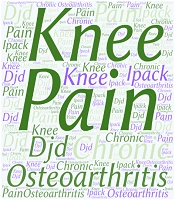Dear Editor,
Pain is perceived in chronic pain patients in many counties. However, pain management is known as a core ethical duty in modern medicine (1). Chronic pain is defined as a condition lasting more than three months (2). Knee osteoarthritis is a common chronic pain condition affecting the aging population (3). The higher prevalence of the disease in adults, especially people over 65 years of age, causes a great economic burden (4). Knee osteoarthritis therapies include a wide range of modalities, including conservative and lifestyle changes, and major surgeries such as joint replacement therapies (5). Cell-based therapy is an emerging treatment modality despite the lack of sufficient documents (6). There is no cure or definitive therapy for knee osteoarthritis, and most physicians recommend weight loss and exercise as a basic management strategy (3-5).
A large number of patients with knee osteoarthritis in need of treatment are elderly people who suffer from debilitating pain for a long time. In many cases, these patients do not receive adequate treatment and may not have taken oral medications to control their pain and inflammation for a long time. Performing minimally invasive procedures, such as cell-based therapies, may not be very satisfying for the patients in the short term because these procedures are associated with delayed optimal effects. In such cases, there is a vacancy for a treatment modality that can fill this gap.
The infiltration between the popliteal artery and capsule of the knee (IPACK) block is a new anesthetic method for controlling postoperative pain in major knee surgeries (7). The IPACK block is a better postoperative pain control method than periarticular multimodal drug injection in total knee arthroplasty patients (8). Performing an IPACK block with relatively long-lasting medications such as corticosteroids in chronic knee pain patients in the same session following therapeutic procedures such as intraarticular injection of platelet-rich plasma, or Orthokine can help reduce the patient’s pain until the ideal effect of the performed method takes place. Proving that this method of pain control is effective and finding an ideal drug regimen requires further investigation.
